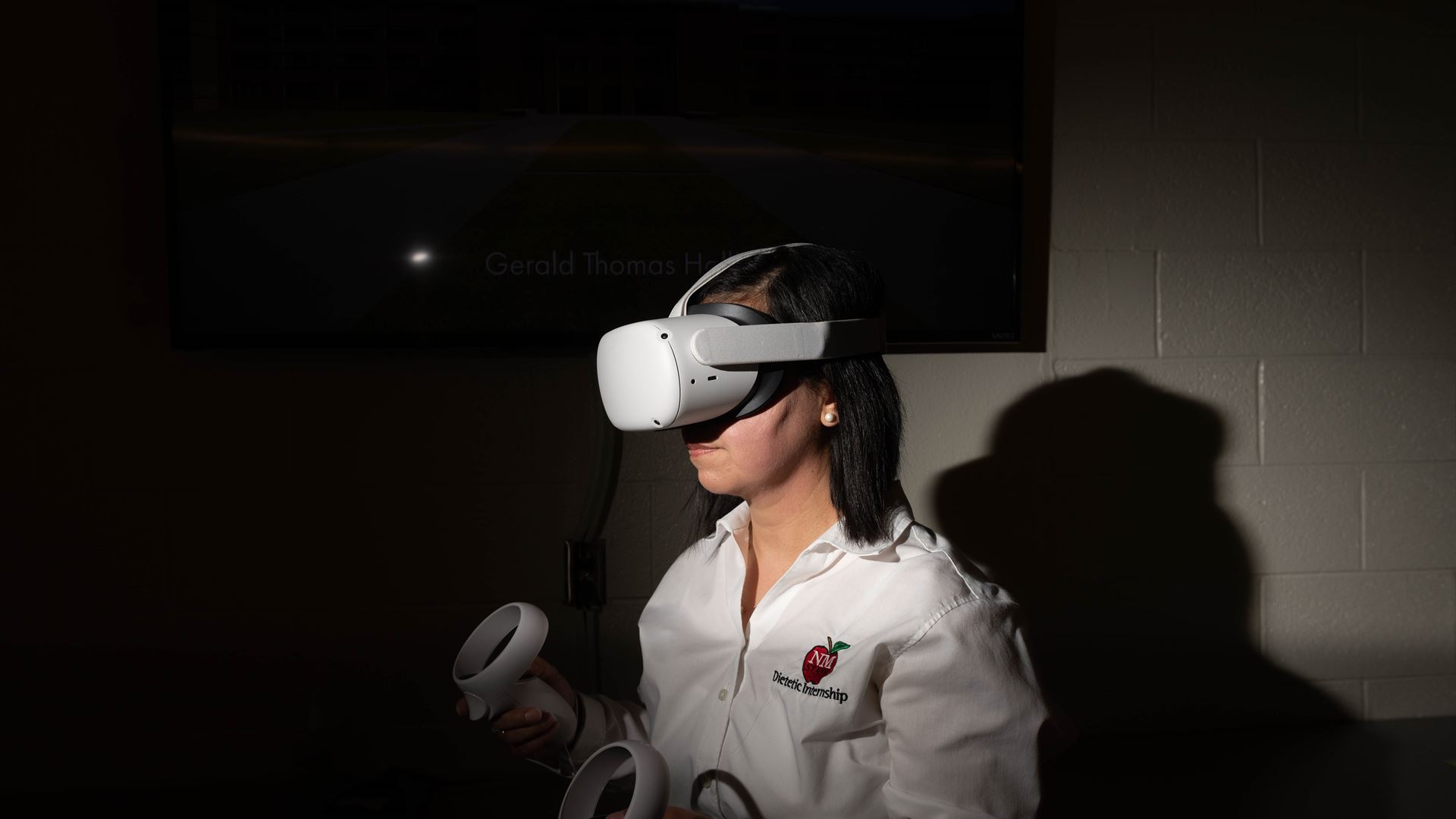Whether using the artificial intelligence mannequin in-person or attending to a holographic virtual reality patient, dietetic students at NMSU gain hands-on clinical practice through a simulated hospital room in Gerald Thomas Hall at the Las Cruces campus.
The virtual hospital room is the newest component of the Dietetic Internship program in the College of ACES.
Gaby Phillips is the director of the program and has developed simulated case studies to train students on the skills they’ll need in real-world settings, giving them a competitive advantage over students from other universities when seeking dietetic internships in hospitals. Phillips used a grant from the Paso del Norte Health Foundation to hire registered dietitians to write scripts for the simulations that mimic real-world scenarios.
“We struggle, as any other clinical program, to place interns in settings for real experiences because of the shortage of health care professionals,” Phillips said.
“When a hospital is short staffed, healthcare professionals will not have the time to take someone under their supervision to give them experience. This was something I encountered and I felt like it was important for my students to gain experience in the simulation lab to make the transition between the classroom and the real experience easier.”
Phillips worked with Boost Human, an El Paso startup company, to create the virtual reality component of the simulation lab. As the pandemic got underway in 2020, Phillips accelerated the process to prepare virtual case studies for her students. She used grant funding to purchase the first mannequin and hospital bed for the program.
“When the pandemic hit, we were already prepared,” she said. “This was used to keep the program going. We could utilize simulation labs and virtual reality to train future registered dietitian nutritionists.”
The first simulation lab uses an artificial intelligence patient programmed with a variety of studies that feature different names and diagnoses. The AI patient has many realistic features including breathing and speaking when prompted to. The patient is connected to the cloud, where it uploads questions asked by students and the cloud interacts with the mannequin. Phillips can access the cloud through her laptop or cellphone which allows her to see the patient’s vitals and control which case study is being worked on.
The second simulation makes use of virtual reality. Students wear a virtual reality headset and work on case studies by interacting with a holographic patient and a registered dietitian in different settings. A script appears above the patient which allows students to easily follow guidelines and ask necessary questions.
“It’s closing the gap between the classroom and the real experience,” Phillips said. “The more they practice and go over the script, the more it becomes beneficial as they gain confidence. But it also makes it more natural as they step into a real hospital. They’ll feel more at ease as they know what to say and remember many things they saw through the hologram. They can interact a little more naturally with a patient instead of freezing up and not knowing what to do.”
Completing the Dietetic Internship program is one of the final steps before students can become registered dietitians. They must also complete a master’s degree in family and consumer sciences.
Amanda Apodaca, a 2022 graduate of the Dietetic Internship program, said the simulation provided extensive practice and built up her confidence to interact with patients before her clinical rotations at William Beaumont Army Medical Center in Fort Bliss, Texas.
“The mannequin really pushed us to have difficult patient interactions and work through them with our directors in a safe setting,” Apodaca said. “The simulation lab is as close to the real thing as you can get. I didn’t learn that until I got into my clinical rotation, but it was a great experience to see how similar the interactions are – mannequin versus patient. I realized that I had this experience and that I was capable of handling interactions with confidence. I was able to speak with patients and provide optimal care.”
The Virtual Reality dietetics and simulation curricula became a $750,000 United States Department of Agriculture and National Institute of Food and Agriculture collaborative grant, iENDEAVORS: Innovative Enhancements of Nutrition and Dietetics Education using Artificial Intelligence and Virtual Reality to Overcome Registered Dietitian Nutritionists Shortages.
“We are collaborating with Rutgers University, dietitians and the NMSU Innovative Media Research and Extension Lab, which are all doing a phenomenal job,” Phillips said.
Additionally, Phillips was invited to be one of a few select faculty members at NMSU to teach at the NMSU Digital Twin Metaversity Campus starting in fall 2022. Only 10 universities in the U.S. are working on the Metaverse project.
“We are the only dietetic internship program that offers a virtual reality simulation lab, and I was able to bring my students into a virtual hospital room where the dietetic interns did a swallowing screen and inserted nasogastric feeding tubes which are both part of the new clinical standards,” Phillips said. “The virtual reality NMSU campus always surprises me, there’s so much potential of what we can do to keep our students engaged and educate future healthcare professionals.
“I’m beyond grateful for all the experiences and activities that NMSU can offer to dietetic interns and registered dietitians. We’ll be bringing the virtual reality and simulation lab to hospitals in the region to train our partners who kindly accept our interns for supervised practice rotations. This is a hands-on activity that we are offering to all our kind preceptors who share their knowledge and time to supervise future registered dietitians.”
Phillips believes the simulation lab represents the future of health care education.
“I’m proud to say that New Mexico State University is pioneering in the dietetics virtual reality curriculum,” she said.
A version of this story was first published in the fall 2022 issue of ACES Magazine. To read the issue, visit https://aces-about.nmsu.edu/documents/ACESMagazine_FA22_web.pdf.

